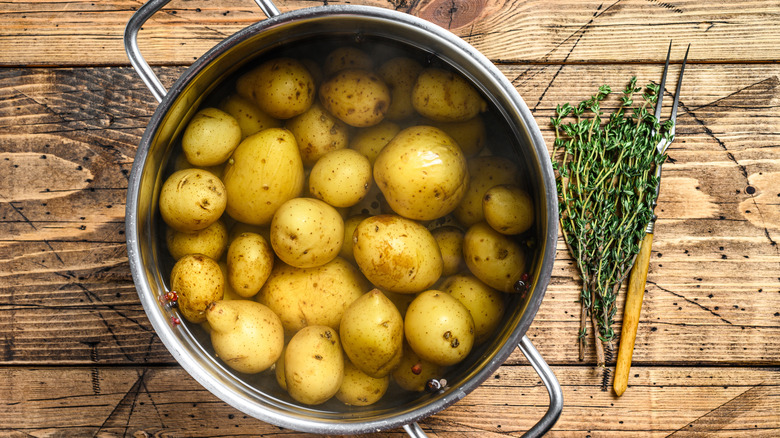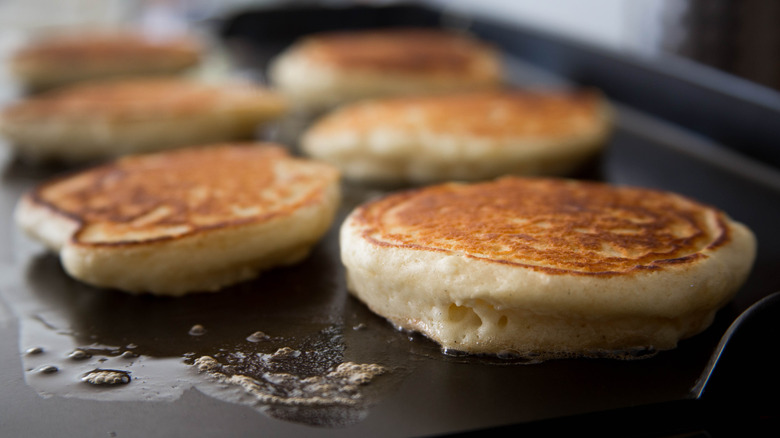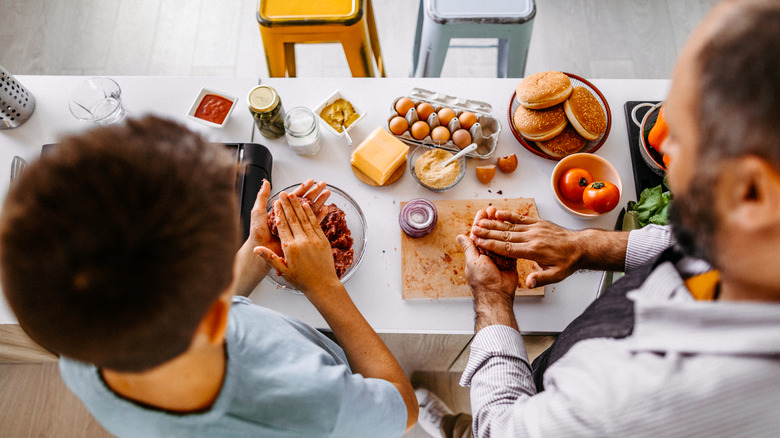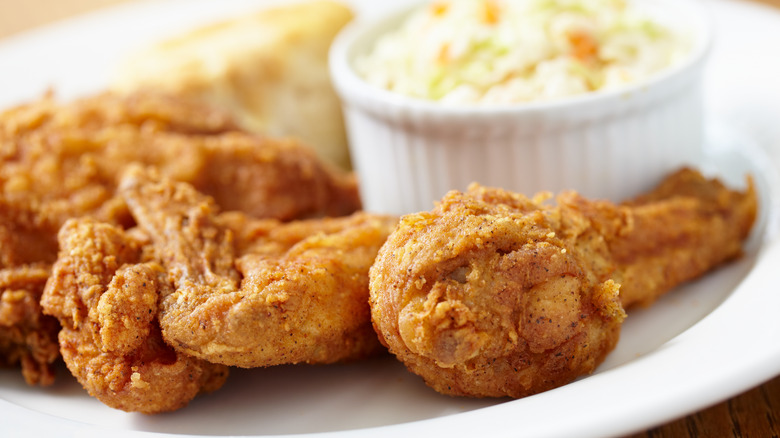Cooking spray might be the most convenient ingredient-slash-tool in your kitchen. You’ve probably got a can of Pam with its red cap on your shelf tucked between the sugar and flour, ready to help you prep a pan for baking. It’s handy, convenient, and incredibly effective — but what exactly is in that can?
Whether your cooking spray of choice is Pam’s classic canola oil, an olive oil blend, or on-trend coconut or avocado oil, most varieties contain similar ingredients: oil, an emulsifier (usually soy lecithin, which is also a stabilizer), and a propellant to give you a fine, even mist with each spritz. Some more specific varieties include flavorings such as butter or flour to transform regular cooking spray into a baking superpower.
Sprays made with coconut or avocado oil often cut that list even shorter, eliminating propellants and sometimes even the emulsifier, getting down to only one or two ingredients. Many of these specialty cooking sprays are diet-friendly, too — they’re often non-GMO, gluten-free, or paleo-friendly, perfect to have on hand no matter who you’re cooking for.
Cooking spray is great for greasing pans, of course, but that’s not all it can do. No matter where you look in your kitchen, there’s a cooking spray hack that will help you be a better cook.
Keep parchment paper in place

The most popular use for cooking spray is to keep food from sticking, but it’s also pretty handy at getting things to stick, too. When you’re baking a cake or prepping a sheet pan for a long roast, chances are you’ll turn to parchment paper to double up on your nonstick preparations. But big sheets of parchment paper are notorious for curling up after all that time on a roll, or slipping around while you’re trying to finish your recipe.
Enter cooking spray! Even if you’re not planning to put a layer of cooking spray on top of your parchment paper, applying a few spritzes on the pan before you place your sheet on it will help keep the parchment in place once it’s time to arrange your veggies for roasting. For cakes that come out of the pan like a breeze, spray your entire cake pan with cooking spray, cut a piece of parchment paper to fit the bottom of your pan and place it on the cooking-sprayed surface, then add another spritz of cooking spray on top of the paper to ensure it peels off easily after baking.
Ensure clean slices

Is there anything more aggravating than trying to dice dried fruit and winding up with a giant sticky clump hanging off of your knife? Garlic also loves to stick to knives, as it is full of both fructose and a chemical compound called diallyl trisulfide, which combine to make this bulb surprisingly sticky when cut. For a neater knife, cleaner cutting board, and more even slicing and dicing, turn again to cooking spray.
Before you start chopping, spritz your knife on both sides with a bit of cooking spray. It won’t impact your sharp edge, but it will create a barrier between the garlic and the blade. There are two reasons you should turn to cooking spray instead of liquid cooking oil. First, safety: Using cooking spray means you can keep your fingers away from the edge of the blade, a big plus when you’re adding something slippery to the situation. Second, portion control: A quick spritz of cooking spray creates an ultra-thin layer that would be almost impossible to achieve with liquid oil. This means your ingredients won’t stick to your knife, and you also won’t be adding unneeded (or unwanted) oil to your recipe.
Easily measure sticky ingredients

Peanut butter. Honey. Molasses. Corn syrup. Whether you’re making salted peanut butter bars or honey cake, sticky kitchen ingredients can bring loads of flavor to your recipes — but they also create quite a mess in your measuring cups as you scoop them in and then scrape them out. (And if you’re like us, your fingers and your countertop get pretty sticky in the process, too.) All that struggle to transfer ingredients from cup to bowl can also lead to inaccurate measurements, since there’s almost always some left behind in the measuring cup and on your spoon.
For easy and more accurate measuring, let cooking spray handle the mess. Give your measuring cups a spritz of cooking spray before using them for sticky ingredients. A thin layer will help everything come out into your mixing bowl, no scraping required. Give your spatula a spritz, too, to help the honey or peanut butter on its way into your recipe without having residue left over.
Prevent avocados from browning

Alvarez/Getty Images
For an avocado lover, there’s nothing quite like seeing your patience rewarded with a perfectly ripe slice. But if you’re not going to use the whole piece of fruit on your avocado toast, you’ll wind up with half an avocado in your fridge, which is prone to browning. If you’ve been looking for the best way to store cut avocado, perhaps you’ve tried squeezing on lemon juice, storing it with an onion, or even using a designated avocado storage device to fend off browning — but we’ve got one more tip to try.
The cut surface of avocado turns brown due to oxidation, so minimizing contact with oxygen will help you maintain vibrant green slices. After cutting your avocado, spritz the exposed inner surface with cooking spray. Rub the spray gently to ensure the entire surface is covered, then spritz lightly again. Next, further minimize oxygen exposure by tightly wrapping your avocado in plastic wrap (with the wrap fully touching the avocado) or by storing slices or diced avocado in the smallest possible airtight container. To minimize any flavors imparted by your cooking spray, turn to an avocado oil spray, which will blend seamlessly into your next avocado-based recipe.
Keep water from boiling over

When you are making pasta or boiling potatoes, you’ll probably add salt in the pot to add flavor to your dish. But there’s another addition to the pot that makes the process of managing boiling water a breeze — a cooking spray hack that helps prevent water from boiling over.
There are two main reasons a pot of water might boil over while you’re cooking. The first is that the pot is too full, either because you added too much water in the first place or because the addition of whatever ingredients you’re boiling caused the water to rise higher than you expected. The second reason is if you’re cooking a starchy food like pasta. The addition of starch to the water prevents the bubbles from popping, instead stacking up and spilling over to make a mess on your stove.
This hack won’t help if your pot is simply too full, but if you’re struggling with starchy bubbles, we’ve got you covered. Before you fill the pot, spritz the inside with a light coating of cooking spray. This oil will rise to the water’s surface and interrupt the bubble-making by breaking the surface tension, helping keep the water in the pot.
Make a microwave frittata

Eggs have a horrible habit of sticking if you don’t properly grease your frying pan, or if the pan is too cool or too hot. If you’re making eggs in the microwave, that sticking can get even worse. But being able to make a single-serve frittata in the microwave can be a major morning time-saver, and thankfully, cooking spray is here to help with that.
Before adding eggs to your ramekin or ceramic mug, give the interior a spritz of cooking spray to coat every surface. Make sure to get the corners! Then crack in your egg, whisk it with a fork, and stir in any other ingredients you choose. We’re partial to last night’s leftover veggies, a little diced ham, and some cheese to round it out. Pop it in the microwave for a minute, and know that you’ve got a hearty breakfast on the way — with minimal cleanup required.
Use it to grease pans for pancakes

Anyone who has ever made pancakes knows this seemingly simple breakfast treat comes with a set of challenges. Once you’ve achieved the perfect batter, you still have to stand at the stove and cook each pancake, and finding the right temperature and fat to cook them properly can be tricky. Butter is by far the most delicious, but if the heat is too high you’ll wind up with browned — or burnt — butter before your pancakes cook. Cooking oils have a higher smoke point, but use too much and you’ll wind up with fried dough instead of tender pancakes.
Cooking spray helps you find the balance between that high smoke point and a light application of oil, a trick that has served many a brunch chef and pancake-house pro. The super-thin coating of oil provided by cooking spray mimics the well-lubricated surface of a diner griddle — but remember that you shouldn’t use cooking spray on nonstick cookware, because lecithin, the emulsifier found in some cooking sprays, builds up and is very hard to remove. However, if you’re using a brand that doesn’t contain an emulsifier, spray away!
Avoid stains in plastic food-storage containers

Popping leftovers into a plastic food-storage container and stashing it in your fridge is a great way to ensure another tasty meal ahead. It’s super convenient to simply stick those leftovers in the microwave for reheating before you dig in … but when it’s time to clean out the residue of your leftover Bolognese sauce, you might find yourself wishing you’d used a glass container instead. No matter how much scrubbing you do, some sauces are determined to stay put.
Aside from switching from plastic containers to glass, one way to combat those stains is to do a little bit of prep work before you portion out your leftovers. Some types of plastic are actually porous, and food can find its way into tiny spaces on plastic surfaces and stay there. To avoid this, use cooking spray to prevent stains on plastic food containers. The cooking spray fills in all the gaps, leaving your sauces free to be enjoyed without staining their containers. You’ll also have cooking spray’s nonstick properties working in your favor to help leftovers easily slip out of the container and onto your plate.
Make grating cheese a breeze

Shredded cheese is convenient, but sometimes you just need to grate your own — especially when melting the cheese evenly is of the utmost importance, as packaged shredded cheese often contains an anti-caking agent like potato starch to keep each string separate. This results in lumps, which are definitely not something you want in your cheese sauce.
Once you’ve purchased a block of cheese and taken out your box grater, you might notice cheese smearing and sticking to the metal surface, which is not a recipe for uniform strings or easy cleanup. To keep cheese from sticking to your cheese grater, give it a light spritz of cooking oil before you get started. This will help the block of cheese slide more easily against the blades, encouraging each string to release and fall into your bowl, and also make post-grating cleanup incredibly easy. Simply wipe away the cooking oil with a soapy sponge, no scrubbing required.
Keep food from sticking to your hands

You know cooking spray keeps food from sticking to pans, but did you know it’s just as useful when you’re trying to keep food from sticking to your hands? Hands are the most useful tool in the kitchen, and a quick spritz of cooking spray transforms your fingers into nonstick utensils.
When forming meatballs or burger patties, apply cooking spray to your hands and use them to gently roll balls or press patties. Sure, you could use a scoop or a press, but that runs the risk of using too much force to compact the meat. With your hands, you can be gentle and create looser patties that work best when grilling burgers, which will be tender and juicy even if they’re not picture-perfect.
This trick also works for sticky desserts like homemade Rice Krispies treats. Gentle handling will help keep each treat tender and gooey instead of hard and compact … but melted marshmallow might be the world’s stickiest substance. Since Rice Krispies treats are still warm when they’re shaped, use a piece of parchment paper to protect your fingers. Spray the paper with cooking spray, then lay it on top of your treats with the sprayed side down, and gently press them into the pan to cool.
Get gum out of your hair

Gum in your hair may be a conundrum you left behind in elementary school, but if you have kids at home, this cooking spray hack is for you. You’ll thank us the next time their bubble-blowing contest goes wrong.
Chewing gum is so hard to get out of hair because it has synthetic rubbers and resins that do not dissolve. That’s great for chewing, but it means you might be left with a stretchy mess. You’ve probably heard that peanut butter can help get gum out of your hair, and it works because peanut butter is also hydrophobic. Being so oily, peanut butter and gum stick to one another much more readily than gum does to hair. Of course, peanut butter is messy — not to mention a common allergen — so a less-smeary alternative could save the day.
Cooking spray is exactly that: It is easier to apply precisely and is free of many common allergens. To use cooking spray when removing chewing gum from your hair, spray all sides of the gum with cooking spray and massage it gently. The oil will break down the stickiness of the gum and help it release from your hair, so you can gently separate the two without having to reach for the scissors.
Reheat leftovers perfectly

Using the microwave might be the fastest way to heat leftovers, but giving your food some time in the oven usually delivers better results. We’re looking at you, pizza and fried chicken. Of course, you don’t want to warm up and dry out the food you worked so hard to create (or order) — you want to revive it to its crispy glory, and cooking spray is just the tool for the job.
A little spritz of cooking spray does wonders for reheating food in the oven, ensuring that your leftover meal is just as enjoyable as it was the first time. Keep the oven temperature low, at around 300 degrees Fahrenheit, so the food will warm through evenly without getting dry at the edges. Use a large enough baking sheet or pan so you can leave space between pieces of food for heat to circulate. Then give your food a light, even spritz with cooking oil. This will rehydrate the exterior, especially if the dish being reheated has a breaded crust. The additional oil will help retain moisture and encourage browning, giving your leftovers a new lease on life.
Make your own cooking spray

A can of cooking spray is an essential pantry item, but if you find yourself without one, don’t panic. It’s easy to make your own cooking spray at home, whether it’s by choice or out of necessity.
For a basic DIY cooking spray, all you need is a misting spray bottle, oil, and water. Choose your preferred oil (canola is common in canned cooking sprays, but since you’re making this at home, you can use whatever oil you love), and combine 2 tablespoons of oil with 1 cup of water. Before using, shake the bottle well — since you’re skipping the additives and emulsifiers found in canned cooking spray, you’ll have to do the emulsifying yourself before each use. Food-grade liquid lecithin can be purchased online if you’re planning to regularly make your own cooking spray and want to incorporate an emulsifier, but it’s an added ingredient that isn’t required if you’re okay with a little arm workout before each spritz.







